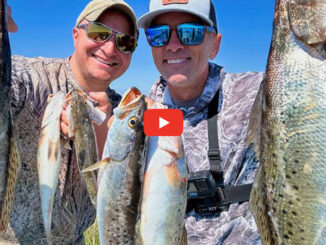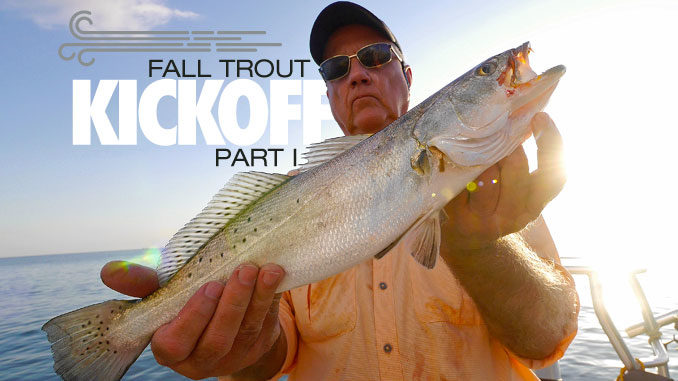
Understand how cooling water affects specks’ feeding habits and locations in Louisiana’s inshore estuaries.
For inshore anglers, the fall fishing season floats in the sweet spot between the heat, stress-driven madness of summer and the slow, cold march of winter.
Fall is the time of year anglers long for, when you can spend an entire day on the water without heat headaches or numb fingers. This is a time not just for fishermen, but also for their silvery dancing partners, happily gorging themselves on marsh delicacies and relaxing in the safety of grass wrapped lakes.
Because speckled trout and redfish, like almost all fish species, are cold -blooded creatures, fall and spring provide the most-comfortable conditions on the Gulf Coast. Some species of sharks and tuna can generate heat from their tail muscles and thus increase their muscle performance in cold water, but they are not truly warm-blooded.
Totally chilled out
Being cold-blooded means that a fish’s body is the same temperature as the water around it, and a fish’s metabolism is directly proportional to its body temperature. In extreme summer temperatures, a fish’s metabolism may go so high that the fish can enter into a state of shock, leading to a drop in metabolic function and eventual death. The opposite is true when the water temperature drops into the 40s; trout and redfish must find warmer water, or their metabolic rate can drop so low that physiological function is nearly stopped. A fish in sustained temperatures below their physiological function range will become sluggish and succumb to a slow death, which hopefully for the fish is like falling asleep. It was observed in Florida that speckled trout died in 24 hours when they could not escape from water temperature of around 45o F.
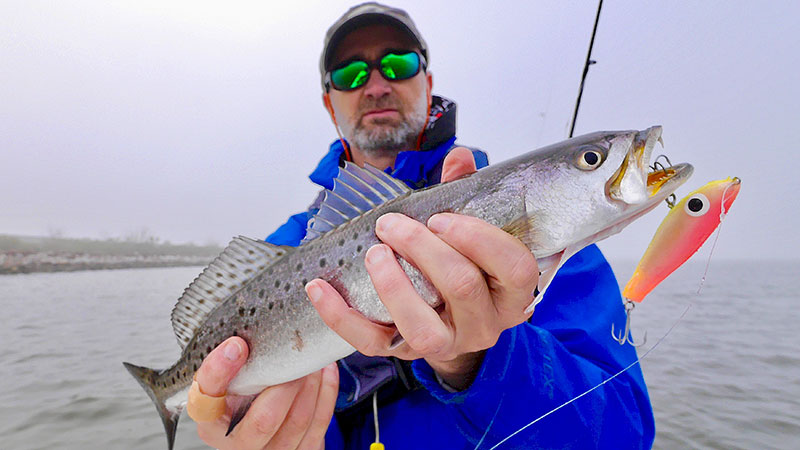
One impact of fall’s colder water is the lengthened period of time between feeding periods for speckled trout and redfish. Their lower metabolic rate means they don’t need to eat for days at a time, which becomes especially noticeable in late fall and winter. While this effect can leave the angler wondering if the fish have all but vanished, the fish are often still there and feeding on the days with the best conditions.
On the move
The need for fish to find warmer water and avoid joining Sleeping Beauty is certainly part of the reason for the event in St. Bernard Parish called the Redfish Jubilee. It is the mid-winter occurrence when thousands of redfish move into a narrow section of Bayou La Loutre near Yscloskey. Such events happen across the Gulf Coast during cold snaps. The Texas Parks and Wildlife Department has, on occasion — as recently as January 2018 — closed saltwater fishing along parts of its coast to protect vulnerable fish that seek refuge in deep channels.
When the water is very cold and fish are not hungry, they can still be enticed into a reaction strike. I have found that a gold spoon on a fast retrieve can cause a reaction strike from a redfish. I have more trout success with a slower action, either from a sinking twitchbait or a jig dragged slowly along the bottom.
Early fall movement
Breeding for speckled trout peters out in September, releasing the fish from the confines of waters high in salinity. While in summer they needed to periodically find salinity greater than 17 ppt in order to spawn, they now can travel freely within an estuary, concentrating fully on eating and not being eaten.
By October, speckled trout push into estuaries, where they meet an abundant migration of white shrimp heading for the Gulf of Mexico. These shrimp grew from post-larva to sub-adults in the protection of the marsh, but they are driven to migrate to the ocean where they will breed and grow until eaten by one of many predators or join the holy trinity in my creole sauce.
Redfish also seek high-salinity water to breed, and they typically do this along the barrier islands. In Louisiana, their breeding period is roughly one month later than speckled trout, so they can breed into October. However, redfish do not reach sexual maturity until their third of fourth years, when they average 26 inches long. This means that redfish from the Louisiana legal minimum length of 16 inches to the sexually mature size of 26 inches can spend an entire year in the middle and upper reaches of an estuary. In early fall, it is primarily the bull redfish, those exceeding 27 inches, that are still out in or near the Gulf and won’t be seen again in the marsh until late fall. But the adolescent redfish are already in the spots where fall anglers will target speckled trout, making this season spectacular.

Location
One of the best inshore locations to find schools of feeding speckled trout in early October is bayous used by white shrimp migrating out of the marsh. When the tide starts falling, the shrimp will leave the bottom, where they have been feeding on detritus, and swim with the current toward the Gulf. The speckled trout will ambush them in narrow sections of bayous, especially at the start of a falling tide. The bite will be epic until the current begins to rip and the trout peel out to avoid excessive energy use.
White shrimp imitations are a good choice of artificial baits in October, but almost any bait will work when a school of trout is exploding on migrating shrimp. Therefore, choosing the right bait is less important than finding those inshore schools of trout. In early October, I’m prepared to search a wide area, because trout have yet to establish their fall inshore patterns.
Hot November
November is an epic month for inshore fishing in Louisiana, because many breeding-sized trout are residents of the inside waters of our estuaries. Their presence ranges from the outer fringes of the marsh to the inside lakes, bayous and channels. They seem to be everywhere, from lakes 3 feet deep to the 10-foot-deep edges of the ICW and the MRGO, and the 15-foot depths of Lake Pontchartrain.
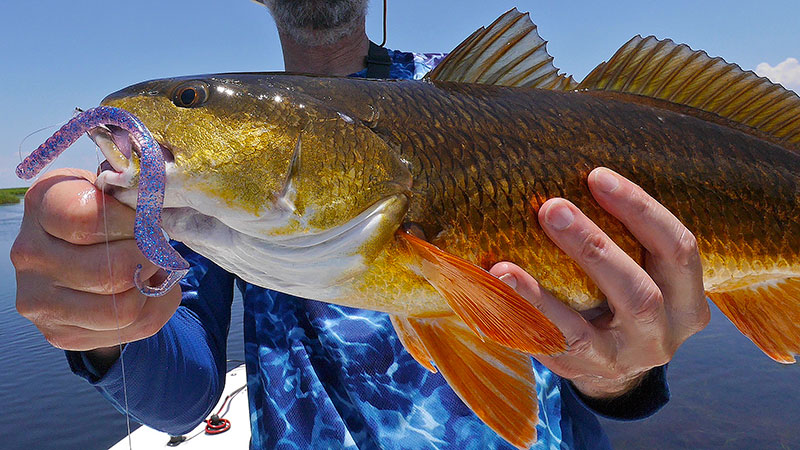
November is the start of a period when a quality sonar unit with imaging capability adds value to speckled trout fishing. Fish will begin targeting schools of baitfish in deeper water, bait that is clearly visible on sonar but invisible from above the water. A sonar unit also allows you to spot structure like rocks and drop-offs, where trout will stage to ambush prey.
If you want to learn fishing with artificial baits but still have a good chance at catching a mess of trout, this is the month when your first cast of the morning should propel a jerkbait or a swimbait and not a live shrimp. In November far fewer white shrimp are still in the marsh, so the trout are also looking for finfish foods such as mullet, cocahoe minnows (killifish), storm minnows (fat sleeper), pot belly minnows (sheepshead minnow), inland silversides and croakers. This convergence of events makes the trout respond willingly to lures that imitate minnows, even when used by a new hand.
Cold fronts
November is also the month when cold fronts first crash down on the Gulf Coast. These meteorological brimstones wreak havoc on the epic fishing. Their strong north winds drain the marsh and turn the shallow lakes into a slurry of silt. The falling air temperatures, cloud cover and cold rain can quickly drive down the water temperature and shut down fish metabolisms. So not only is the bite disrupted by poor feeding conditions, fish don’t need to eat as frequently. Piling pain upon agony, cold fronts also have a mysterious affinity for weekends.
Fortunately, there are fishing strategies to beat the cold front’s assault. First, don’t fish in dirty, rough water. Some calm and adequately clear water is available somewhere to fish. This can be on protected shorelines, dead-end canals, deep cuts and channels. Deep bayous are worth investigating, but many times they are inundated by a flow of dirty water, so look for bayous that are no longer the main path for water flow in the marsh. Often, I will move upwind in the marsh until I can not go any further, and the water conditions there will be improved.
December cheer
December is one of my favorite months to fish in coastal Louisiana for a number of reasons. For one, a warm and calm December day can yield as many fish as any other month. Trout are eating less frequently, but when it’s time to eat, they will likely do so in groups for maximum efficiency, making for epic fishing trips. There are also fewer fishermen in the marsh, and the lower fishing pressure improves the potential for catching larger fish. An by December, the high concentrations of trout and redfish have moved close to the launches, sending more of my time into the fishing rod and less onto the throttle.
Trout can be caught in many locations in December, seemingly without rhyme or reason. However, as a rule of thumb, I will target them in deeper water on cold days and move up in depth on warmer days. Deeper water may be 15 to 20 feet in a channel or 6 feet in a canal. It seems that trout define their refuge depth relative to the water depths available in the area where they are living.
Sonar
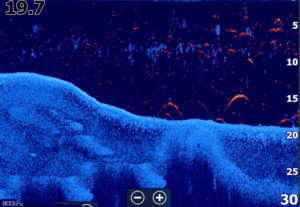
In December, you should take some time away from casting, and put it toward watching your sonar unit to understand the bottom topography of the channel and how you might position yourself for optimal bait presentation.
A great bait for December is a jig with a soft-plastic paddletail. It bait can be fished shallow or deep, although you will need to change weights from as light as 1/8-ounce to as heavy as 1/2-ounce, depending on the water depth you are fishing. In deep water, I always fish the jig on the bottom and so will choose 3/8- to 1/2-ounce. On many days, the key to success with a paddletail or other swimbait is a slow drag along the bottom.
This is a great time to pull out the sinking twitchbaits, like Corkys, and work them slowly. I like to fish a Fatboy in deep water, letting it fall naturally to the bottom on a slack line, jerk it up 5 feet, and then follow with another slow sink. The big December trout will usually suck the bait in as it’s sinking.
Click here to read Part II.
